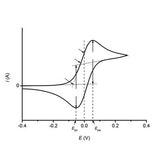Electrochemical Cells
An electrochemical cell is a device that either produces electricity from a chemical reaction, or uses electricity to initiate a non-spontaneous chemical reaction.
Our electrochemical cells have been designed for cyclic voltammetry, electrolysis and other electrochemical studies. Combined with our new Ossila Potentiostat our electrochemistry range has everrything you need to perform cyclic voltammetry in your commercial, academic or teaching lab.
Whether you need temperature control, inlets for degassing, a luggin capillary or h-type cell separation, we have you covered.
Browse Electrochemical Cells
Related categories: photoelectrochemical cells, potentiostat, equipment accessories, electrodes, electrochemistry
Filter by feature:









